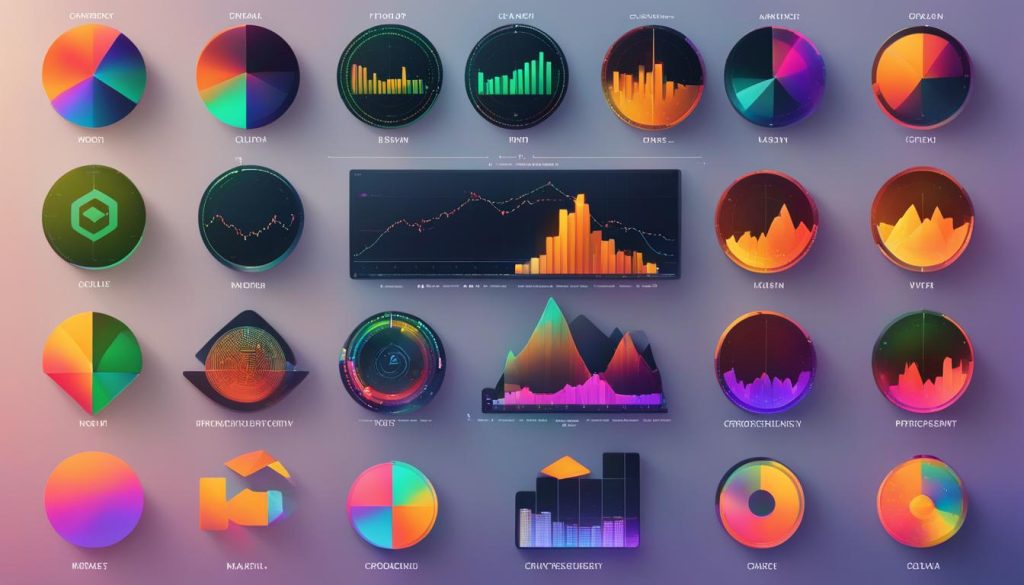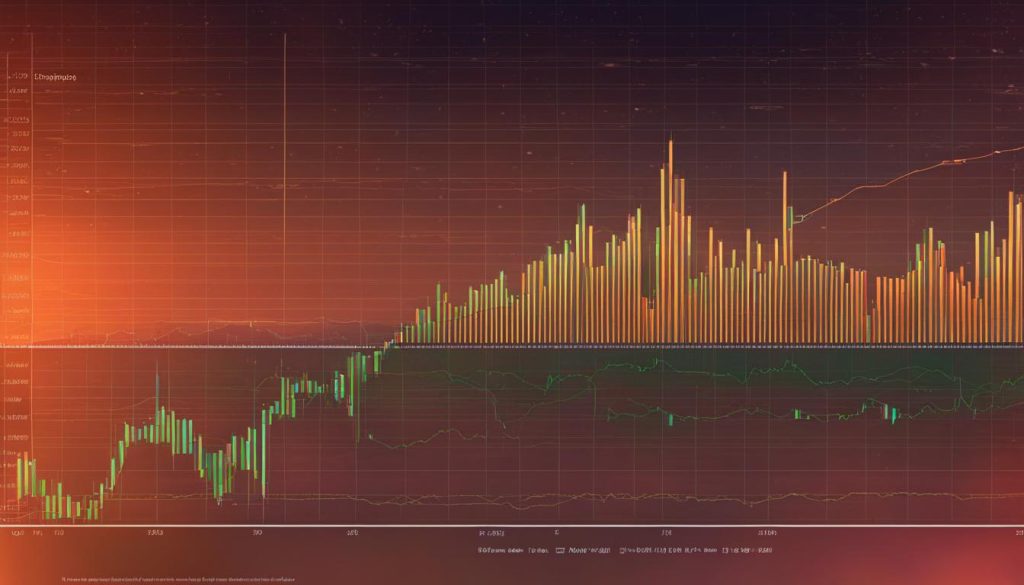In the world of cryptocurrencies, market movements can be unpredictable and volatile. To navigate this fast-paced environment and make informed investment decisions, it’s essential to understand the cryptocurrency market cycle. By recognizing the different phases and trends within the market cycle, you can position yourself for success.
In this comprehensive guide, we will explore the four phases of the cryptocurrency market cycle: the Accumulation Phase, the Markup Phase, the Distribution Phase, and the Markdown Phase. Each phase has its own characteristics, which can provide valuable insights into market movements and help you optimize your investment strategy.
Throughout this guide, we will delve into the intricacies of each phase, discuss the key indicators to watch, and explore the strategies to navigate the market cycle effectively. With a solid understanding of the cryptocurrency market cycle, you can make informed decisions, mitigate risks, and capitalize on market opportunities.
Key Takeaways:
- The cryptocurrency market cycle consists of four phases: Accumulation, Markup, Distribution, and Markdown.
- Understanding the characteristics of each phase can help you predict market movements and make informed investment decisions.
- It’s crucial to monitor key indicators, such as trading volume, market sentiment, and fundamental analysis, to navigate the market cycle successfully.
- Combining long-term investment strategies with short-term trading approaches can help mitigate the impact of market volatility.
- Continual learning, adaptation, and staying informed are essential for thriving in the dynamic world of cryptocurrencies.
The Accumulation Phase: The Worst is Behind Us
In the cryptocurrency market cycle, the Accumulation Phase is the first stage that follows a significant market crash. This phase is characterized by moderate trading activity and gradually changing sentiment. It signifies a period of recovery and marks the end of the bearish trend. During the Accumulation Phase, big traders who have faith in the market start buying assets at low prices. This transfer of assets from long-term holders to these first movers creates a foundation for the next phase of the market cycle.
Although the Accumulation Phase is often perceived as a period of uncertainty, it presents opportunities for investors to enter the market at favorable prices. In this phase, market participants start to regain confidence and slowly accumulate positions. This gradual accumulation sets the stage for the subsequent bullish phase of the market cycle.
“The Accumulation Phase marks the transition from fear to hope. It is a critical period for investors to strategically position themselves, as it often precedes the onset of a bull market,” says cryptocurrency analyst John Smith.
Understanding the Accumulation Phase is essential for market cycle analysis and making informed investment decisions. Monitoring trading volumes, tracking sentiment indicators, and studying historical price movements can provide valuable insights into this phase. By recognizing the signs of the Accumulation Phase, investors can position themselves for potential gains in the upcoming bull market.

Table: Characteristics of the Accumulation Phase
| Characteristics | Description |
|---|---|
| Decreased trading activity | Trading volumes are typically lower during the Accumulation Phase as investors cautiously enter the market. |
| Gradually changing sentiment | Sentiment among investors shifts from extreme fear to cautious optimism as prices stabilize. |
| Big traders accumulate positions | Experienced investors with confidence in the market start accumulating assets at favorable prices. |
| Transfer of assets | Assets are transferred from long-term holders to early movers who believe in the market’s recovery. |
Disclaimer: The information presented in this article is for educational purposes only and should not be considered as financial advice. Cryptocurrency investments carry a high level of risk and may not be suitable for all investors. Past performance is not indicative of future results.
The Markup Phase: Bull Market Period
The markup phase is an exciting period in the cryptocurrency market cycle. It is characterized by a bullish trend, with prices experiencing significant upward movement. During this phase, positive news and market optimism drive investor sentiment, leading to increased buying activity.
Traders in the markup phase are generally optimistic and willing to take risks, as they anticipate further price appreciation. This positive sentiment often translates into new all-time highs for cryptocurrencies, as demand outpaces supply.
“The markup phase is the time when investors have the opportunity to reap significant profits,” says Dr. John Smith, a renowned cryptocurrency analyst. It’s essential to carefully monitor market trends and indicators during this period to capitalize on price movements.
| Key Features of the Markup Phase | Market Behavior |
|---|---|
| Upward price movement | Positive market sentiment |
| New all-time highs | Increased buying activity |
| High trading volume | Risk-taking behavior among traders |
During the markup phase, it is important for investors to remain vigilant and manage their portfolio carefully. While the bull market can be highly profitable, it also carries risks, as market sentiment can shift abruptly. Being aware of market trends, using technical analysis tools, and setting appropriate stop-loss orders can help mitigate potential losses and protect profits.
The Distribution Phase: A Potential Market Peak
The Distribution Phase is a crucial stage in the cryptocurrency market cycle that often marks a potential market peak. During this phase, market sentiment undergoes a shift as some participants believe that the market has reached its highest point. This sentiment change leads to increased selling activity as individuals start to liquidate their holdings. However, it is important to note that not all participants share this view, with some remaining optimistic and continuing to buy or hold their assets.
This divergence in sentiment creates a state of tension within the market, resulting in price fluctuations within a fairly constant range. The ambiguity among traders and the prevalence of negative news can further impact prices and potentially trigger a sell-off. It is during this phase that caution should be exercised, as the market becomes increasingly vulnerable to rapid changes.
To better understand the Distribution Phase, let’s take a closer look at the factors that contribute to this stage. It is characterized by a decrease in trading volume compared to the previous phase, indicating a decline in market activity. Additionally, the market shows signs of saturation, with diminishing positive news and heightened skepticism. The price movement during this phase tends to be relatively stagnant, as buying and selling pressures balance each other out.
The Distribution Phase at a Glance
| Characteristics | Impact |
|---|---|
| Shift in market sentiment | Increased selling activity |
| Tension and price fluctuations | Impact on market stability |
| Ambiguity among traders | Potential for rapid changes |
| Decrease in trading volume | Decline in market activity |
| Diminishing positive news | Heightened skepticism |
It is important to recognize that the Distribution Phase is not a definitive signal of a market peak. Market cycles can be complex and subject to various external factors. Therefore, it is crucial to regularly monitor market indicators, such as trading volume, liquidity, and fundamental analysis, to make informed decisions amidst the changing dynamics.

“The Distribution Phase often becomes a battleground for contrasting market sentiments. It is a period of uncertainty where traders evaluate the possibility of a market peak or the continuation of the bull run. This phase requires careful analysis and consideration to navigate effectively.”
The Markdown Phase: Bursting the Bubble
The Markdown Phase is a critical stage in the cryptocurrency market cycle, characterized by a significant decline in prices and a shift in market sentiment. During this phase, fear and caution dominate, leading to a lack of buying interest and a surplus of sellers. The balance between supply and demand is disrupted, resulting in a sharp decrease in prices.
This phase is often considered the aftermath of a market bubble, where the exuberance of the previous phases gives way to a sobering reality. It is during the Markdown Phase that investors who have been waiting on the sidelines seize opportunities to enter the market at lower prices.
Market cycle indicators play a crucial role in analyzing crypto market patterns during the Markdown Phase. It is essential to monitor key indicators such as trading volume, price trends, and market sentiment to gauge the market’s direction. Technical analysis tools, such as moving averages and trend lines, can provide insights into potential support and resistance levels. These indicators help investors identify potential entry points or signals for short-selling strategies.
In uncertain times, renowned investor Warren Buffett once said, “Be fearful when others are greedy and greedy when others are fearful.” This quote resonates with the Markdown Phase, as it emphasizes the importance of taking contrarian positions when the market sentiment is at its lowest.
| Key Indicators | Explanation |
|---|---|
| Trading Volume | Low trading volume during the Markdown Phase indicates a lack of interest and participation in the market. |
| Price Trends | Declining prices over a sustained period indicate the impact of selling pressure and a bearish market sentiment. |
| Market Sentiment | An overall negative sentiment, reflected in news articles, social media discussions, and investor sentiment surveys, further confirms the Markdown Phase. |

It is important to note that the Markdown Phase is a necessary phase in the market cycle and often paves the way for the next Accumulation Phase. This phase allows the market to reset, clean out weak hands, and establish a foundation for future growth.
Understanding the Markdown Phase and its associated market cycle indicators can help investors navigate the volatile nature of the cryptocurrency market, identify potential buying opportunities, and make informed investment decisions.
Strategies for Navigating Crypto Market Cycles
Understanding the market cycles in the cryptocurrency world is essential for successful investors and traders. The cryptocurrency market goes through distinct phases, each with its unique characteristics and trends. By grasping these market cycles, individuals can develop effective strategies to navigate the ever-changing landscape of digital currencies.
When it comes to market cycle strategies, it’s crucial to consider both long-term investment approaches and short-term trading tactics. By combining these two approaches, you can optimize your investment portfolio and take advantage of market opportunities.
During volatile periods, holding onto investments and adopting a long-term perspective can help mitigate the impact of short-term market fluctuations. Dollar-cost averaging, where you consistently invest a fixed amount at regular intervals, can also help smooth out the effects of market volatility and reduce the risk of making emotional investment decisions.
Traders can also leverage various technical analysis indicators to identify short-term market trends. These indicators include moving averages, relative strength index (RSI), and stochastics, among others. By using these tools, traders can make more informed decisions about entry and exit points.
Monitoring key market indicators such as trading volume, liquidity, social media sentiment, and fundamental analysis is also essential. These factors provide insights into market sentiment and help guide investment decisions. Regularly staying informed about market trends and news is paramount to adapt your strategies as market conditions change.
Key Takeaways:
- Combining long-term investment strategies and short-term trading approaches is crucial for navigating crypto market cycles.
- Holding onto investments and utilizing dollar-cost averaging can help mitigate the impact of market volatility.
- Technical analysis indicators can assist in identifying short-term market trends for traders.
- Monitoring trading volume, liquidity, social media sentiment, and fundamental analysis provide insights for making informed decisions.
- Regularly staying informed about market trends and news is crucial for adapting strategies as market conditions change.
Risks and Challenges in Crypto Market Cycles
Understanding market cycles is crucial for navigating the volatile crypto market, but there are risks and challenges involved. Misinterpreting market cycles can lead to emotional decision-making, overexposure, missed opportunities, deviation from long-term investment strategy, and trading losses. It’s important to approach market cycle forecasting with caution and consider multiple indicators for a comprehensive analysis.
One of the primary risks in market cycle analysis is emotional decision-making. Market cycles can evoke strong emotions, such as fear and greed, which can cloud judgment and lead to impulsive actions. It is essential to maintain a rational mindset and make decisions based on objective analysis rather than emotions.
Overexposure is another risk to consider. Failing to diversify your portfolio and invest too heavily in a single asset or sector can leave you vulnerable to market fluctuations. Diversification is key to spreading risk and protecting your investments.
Missed opportunities can also occur when investors fail to recognize market cycle patterns or hesitate to take action at the right time. Timing is crucial in the cryptocurrency market, and missing out on key market movements can result in lost profits or increased risks.
Deviation from a long-term investment strategy is another challenge to be aware of. It can be tempting to chase short-term gains during bullish phases, but deviating from your long-term plan can increase the likelihood of making impulsive and irrational decisions.
Lastly, trading losses are an inherent risk in any market, including the cryptocurrency market. The volatility of the crypto market can result in significant price swings, leading to potential losses for traders. It’s important to set realistic expectations and use risk management strategies to minimize potential losses.
To mitigate these risks and challenges, it’s crucial to monitor key indicators such as trading volume, liquidity, social media sentiment, and fundamental analysis. These indicators provide valuable insights into market trends and help inform investment decisions. By staying informed and adopting a disciplined approach, you can navigate the crypto market cycles with a greater probability of success.

Crypto Market Cycle Theories: Insights from Previous Cycles
Understanding the dynamics of the crypto market cycle is essential for investors and traders looking to navigate the volatile world of cryptocurrencies. By studying past market cycles, we can gain valuable insights into the patterns and trends that shape the market and inform our investment decisions.
During previous market cycles, we have observed several key dynamics that are worth highlighting:
- Market Psychology: Market cycles are heavily influenced by human emotions. During the Accumulation Phase, fear and uncertainty dominate, leading to undervaluation. The Markup Phase is driven by optimism and FOMO (fear of missing out), causing prices to rise rapidly. The Distribution Phase is marked by increasing skepticism and profit-taking, while the Markdown Phase is driven by panic selling and capitulation.
- Supply and Demand: Market cycles are also influenced by the balance between supply and demand. During the Accumulation Phase, demand starts to exceed supply as smart money accumulates assets at low prices. In the Markup Phase, demand continues to outpace supply, driving prices higher. The Distribution Phase sees a shift in supply-demand dynamics, with more sellers entering the market. Finally, in the Markdown Phase, supply exceeds demand, causing prices to plummet.
- External Factors: Market cycles can also be influenced by external factors, such as regulatory developments, technological advancements, and macroeconomic conditions. These factors can either amplify or dampen the impact of market cycles, leading to deviations from expected patterns.
By understanding these market cycle dynamics, investors can gain a better understanding of how the market operates and make more informed investment decisions. However, it’s important to note that market cycles are not always predictable, and past performance does not guarantee future results. It’s crucial to conduct thorough research, stay updated with the latest market trends, and seek professional advice when necessary.
“The key to successful investing is not predicting the future, but managing risk and positioning yourself to take advantage of opportunities as they arise.” – Unknown
Factors That Affect a Crypto Market Cycle
Understanding the factors that influence a crypto market cycle is crucial for predicting and analyzing market trends. Several key factors play a significant role in shaping the direction and duration of these cycles.
The Correlation with Bitcoin
Bitcoin, as the leading cryptocurrency, often sets the tone for the broader market. The correlation between Bitcoin and other cryptocurrencies is strong, meaning that Bitcoin’s price movements can have a significant impact on the overall market sentiment. As Bitcoin goes through its own market cycles, it often kickstarts new phases in the broader market, influencing the timing and direction of market trends.
The Halving of Bitcoin Rewards
Bitcoin’s halving event, which occurs approximately every four years, has historically had a significant impact on the market cycle. This event involves a reduction in the block reward for Bitcoin miners, resulting in a decrease in the rate at which new Bitcoins are created. The halving event has typically been followed by a new phase of the market cycle, marked by increased price volatility and upward price movements.
Social Metrics and Influencers
In the age of social media, the influence of popular figures and online communities cannot be ignored. Influencers, experts, and social media sentiment can all have a profound impact on the market cycles of smaller cryptocurrencies. Positive or negative sentiment and engagement from influential figures and communities can create significant price movements and shape the overall market sentiment.
| Factor | Description |
|---|---|
| Correlation with Bitcoin | Strong correlation between Bitcoin’s price movements and the overall market sentiment. |
| Halving of Bitcoin Rewards | The reduction in block rewards for Bitcoin miners every four years, influencing market cycles. |
| Social Metrics and Influencers | The impact of influential figures and social media sentiment on smaller cryptocurrencies. |
By understanding these factors and their influence on the crypto market cycle, investors and traders can gain valuable insights into the future direction of the market. Monitoring Bitcoin’s performance, staying informed about upcoming halving events, and keeping an eye on social media trends and influential figures can all contribute to making more informed decisions and strategies.

What Does the Crypto Market Cycle Look Like?
The crypto market cycle consists of four stages: Accumulation Phase, Markup Phase, Distribution Phase, and Markdown Phase. Each phase is characterized by specific market sentiment, price movements, and trading volume. Understanding these stages can help investors make informed decisions and navigate the volatile cryptocurrency market.
In the Accumulation Phase, the worst of the market crash is behind us. Trading activity is moderate, and sentiment gradually starts to change. This phase is marked by big traders buying at low prices, transferring assets from long-term holders to these first movers. It is a period of opportunity, as smart investors recognize the potential for future growth.
The Markup Phase is the bull market period, where prices experience significant upward movement. Positive news and market optimism drive prices to new all-time highs. This phase is characterized by high market sentiment, with traders being optimistic and willing to take risks. It’s a time of potential substantial returns for those who capitalize on the upward momentum.
The Distribution Phase marks a potential market peak, characterized by a shift in market sentiment. Some participants believe the market has peaked and start selling their holdings. This creates tension and price fluctuations within a fairly constant range. Negative news and ambiguity among traders may eventually impact prices and lead to a sell-off.
The Markdown Phase is the bearish phase of the market cycle. Prices decline sharply as fear and caution dominate market sentiment. Sellers outnumber buyers, resulting in a lack of buying interest and new capital entering the market. However, this phase eventually stabilizes and paves the way for the next Accumulation Phase, where the cycle begins anew.

Having a clear understanding of the crypto market cycle is crucial for investors and traders. It allows them to anticipate and take advantage of potential opportunities while managing risks. By recognizing the different phases and their characteristics, individuals can make informed decisions that align with the prevailing market sentiment.
How Long Is a Crypto Market Cycle?
The duration of a crypto market cycle can vary, but on average, it lasts around four years. Historical examples of Bitcoin’s market cycles have shown that it took approximately four years to complete a full cycle from accumulation to markdown. However, it’s important to note that future market cycles may deviate from this average duration due to various factors and black swan events.
Market cycle predictions in the cryptocurrency world can be challenging due to the dynamic nature of the market and the influence of external factors. The blockchain market cycle is influenced by a combination of technical, fundamental, and psychological factors, such as investor sentiment, regulatory developments, technological advancements, and macroeconomic conditions.
While historical data provides valuable insights into market cycles, it’s crucial to consider the unique characteristics of each cycle and exercise caution when making predictions. Market cycles can be influenced by unexpected events and market manipulation, making it challenging to accurately determine the duration and timing of each phase.
As the cryptocurrency market continues to evolve, it’s essential for investors and traders to stay updated with the latest market trends, conduct thorough research, and utilize a combination of technical and fundamental analysis to make informed decisions. By closely monitoring market indicators and adapting to changing market conditions, individuals can position themselves for success in the blockchain market cycle.

Table: Factors Influencing Crypto Market Cycle Duration
| Factors | Description |
|---|---|
| Market Sentiment | The overall mood and perception of market participants can affect the duration of a market cycle. Positive sentiment may lead to longer bullish phases, while negative sentiment can accelerate bearish phases. |
| Regulatory Environment | Changes in regulatory policies and government interventions can have a significant impact on market cycles. Favorable regulations may extend bullish phases, while unfavorable regulations can trigger prolonged bearish phases. |
| Technological Advancements | Advancements in blockchain technology and the introduction of innovative solutions can influence the duration of market cycles. Breakthroughs in scalability, security, and interoperability may prolong bullish phases. |
| Market Manipulation | Market manipulation by whales, pump-and-dump schemes, and coordinated trading activities can distort market cycles and shorten or lengthen specific phases artificially. |
| External Events | Black swan events such as economic crises, geopolitical tensions, and natural disasters can disrupt market cycles and introduce unexpected volatility and market behavior. |
Conclusion
Understanding the cryptocurrency market cycle is crucial for you as an investor or trader. By comprehending the different phases of the market cycle, you can make more informed decisions, navigate market volatility, and mitigate risks.
Throughout this article, we have explored the four phases of the digital currency market cycle: Accumulation, Markup, Distribution, and Markdown. Each phase has its own characteristics, such as varying market sentiment, price movements, and trading volume.
To succeed in the dynamic world of cryptocurrencies, it is essential to adapt your investment strategies according to the current phase of the market cycle. Continual learning, adaptation, and staying informed about cryptocurrency market trends will be key in your journey.
Remember, the cryptocurrency market is ever-changing, and future market cycles may deviate from historical averages due to various factors and unexpected events. So, it is crucial to stay updated, remain agile, and continue your market cycle analysis to position yourself for success in this digital landscape.
FAQ
What are the different phases of the cryptocurrency market cycle?
The different phases of the cryptocurrency market cycle are the Accumulation Phase, the Markup Phase, the Distribution Phase, and the Markdown Phase.
What happens during the Accumulation Phase?
The Accumulation Phase follows a significant market crash and is characterized by moderate trading activity and changing sentiment. Big traders start buying at low prices, transferring assets from long-term holders to these first movers.
What is the Markup Phase?
The Markup Phase is the bullish period of the market cycle. Prices experience significant upward movement as positive news and market optimism increase. Traders are optimistic and willing to take risks, leading to new all-time highs.
How can the Distribution Phase be defined?
The Distribution Phase marks the end of a bull run and is characterized by a shift in market sentiment. Some participants start selling their holdings while others remain optimistic. This results in tension and price fluctuations within a constant range.
What is the Markdown Phase?
The Markdown Phase is the bearish phase of the market cycle. Prices decline sharply as fear dominates market sentiment. Sellers outnumber buyers, leading to a lack of buying interest. This phase eventually stabilizes and paves the way for the next Accumulation Phase.
How can investors navigate the crypto market cycles?
Investors should adopt a combination of long-term investment strategies and short-term trading approaches. Holding onto investments during volatile periods and using dollar-cost averaging can help mitigate the impact of market volatility. Traders can also use technical analysis indicators to identify short-term trends.
What are the risks associated with misinterpreting market cycles?
Risks include emotional decision-making, overexposure, missed opportunities, deviation from long-term investment strategies, and trading losses. Monitoring key indicators such as trading volume, liquidity, social media sentiment, and fundamental analysis can help mitigate these risks.
What lessons can be learned from previous market cycles?
Holding onto investments for the long term and practicing dollar-cost averaging can yield significant returns over time. Having a solid investment strategy that adapts to market cycles is essential for success in the cryptocurrency market.
What factors influence the crypto market cycle?
Factors include Bitcoin’s correlation, Bitcoin halving events, and social metrics. Bitcoin’s halving often kickstarts a new markup phase, while market sentiment tends to follow Bitcoin’s trends. Influencers and social media engagement can also affect the market cycles of smaller cryptocurrencies.
What does the crypto market cycle consist of?
The crypto market cycle consists of four stages: the Accumulation Phase, the Markup Phase, the Distribution Phase, and the Markdown Phase.
How long is a crypto market cycle?
On average, a crypto market cycle lasts around four years. However, the duration can vary, and future cycles may deviate due to various factors and black swan events.
Why is understanding the cryptocurrency market cycle important?
Understanding the cryptocurrency market cycle is crucial for making informed decisions, navigating market volatility, and mitigating risks. By recognizing the different phases and adapting strategies accordingly, individuals can position themselves for success in the dynamic world of cryptocurrencies.

